Xiangqi (Chinese Chess) Basics 02 How to Play Xiangqi
Xiangqi (aka Chinese Chess, 象棋 xiàngqí ) is a turn-based game of strategy that is played by two players. Although millions across Asia play the game, it is not very well-known outside of the Chinese-speaking realm. A lot of Westerners believe Xiangqi to be the same as Chinese Checkers, Go, Shogi, Janggi, or other forms of oriental games. The goal of www.xqinenglish.com is to spread the game to the world. And the first order of business and perhaps the most important article would be to share with the West how to play the game itself.
How to Play Xiangqi
Learning how to play a game of Xiangqi would mean to learn how to move the chess pieces on the Xiangqi chessboard to capture the enemy king. There are seven different types of Xiangqi chess pieces, and each piece has its way of moving and capturing enemy pieces. Simple rules are followed, and the main objective is to capture the enemy king. This article will contain a very short summary of how to play Xiangqi.
- Material needed
- Simple Rules
- Differences in the Rules as compared to International Chess
- The Xiangqi Chessboard
- The Xiangqi Pieces
- An Important Reminder
- FAQs on How to Play Xiangqi
Material needed
To play a game of Xiangqi, a Xiangqi set which includes a chessboard and chess pieces. The board should be big enough to accommodate the chess pieces, which are divided into two colors: Red and Black by default.
Simple Rules
The following are the most basic rules that a player must know.
- The main objective or goal for a player would be to capture the enemy King. If neither color can capture the enemy king, it would be a draw.
- Red would make the first move by default, followed by Black.
- The pieces are moved, and the process is repeated until:
- one of the Kings is captured, which would end the game automatically, and give the win to the player who managed to capture the enemy king,
- one of the players resigns,
- a stalemate appears, which would be considered a loss for the King placed under stalemate!
- both players agree to a draw,
There is a special rule in Xiangqi that is called the Royal Rule that was coined by Mr. Felix Tan, a very well-respected Xiangqi promoter from Singapore. This rule will be introduced in the sub-section introducing the King.
In 2018, the World Xiangqi Rules were published, which unified the rules of play for tournaments outside of China. It is the golden standard for tournaments outside of China. There was also an English version of the Rules for the first time, which the Webmaster has translated. The Webmaster is very honored for this contribution. The recommendations in the World Xiangqi Rules are the official standard, and they are used in this article. (1)
Obtaining the World Xiangqi Rules can be difficult. To date, it can be bought on Chinese Websites. Click here.
However, the Webmaster would suggest that the interested reader approach his nearest local Xiangqi association and ask them for help.
The rules published by the Chinese Xiangqi Association is the golden standard for tournaments inside China. The latter set of rules is much harder and taxing on the competitors. It was designed purposely in such a manner to decrease the number of games ending in a draw.
Note: In Xiangqi, by default, Red would make the first move, and thus have the first-move initiative. However, this was not always so. For reasons not known to the Webmaster, when the CXA was first formed in 1956, the committee in charge of the rules decided that Black was the first to move. The decision was reversed in 1981. This interesting rule would explain why in some of the older Xiangqi manuals, the diagrams are arranged such that Black would be placed at the bottom of the page, and Black would go first. (2 页 11)
In ancient times, Red was the first to move.
Click here to return to the top of the page.
Differences in the Rules as compared to International Chess
There are several important differences that any player with a background in International Chess must know when playing Xiangqi. They include:
- A stalemate would be a loss for the King placed under it.
- There is no such thing as castling;
- There is no such thing as promotion of the Pawns
- There is no such thing as en passant of the Pawns,
- Perpetual Checks are NEVER EVER ALLOWED. The player delivering perpetual checks would lose automatically if he refused to change his moves.
There are many differences between Xiangqi and International Chess. Please refer to the link to another article, Comparing Xiangqi and International Chess, which the Webmaster has written.
The next thing to learn would be an introduction to the Xiangqi chessboard and the pieces.
The Xiangqi Chessboard
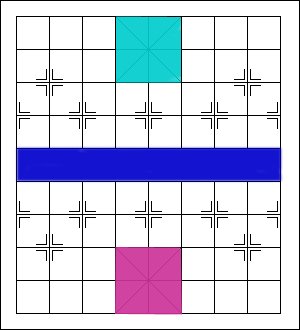 A Xiangqi chessboard would look like the diagram shown on the right:
A Xiangqi chessboard would look like the diagram shown on the right:
The space in the middle, shaded blue, is the river. Sometimes, the Chinese ideograms 楚河汉界 is inscribed in the river to remind players of the Chu-Han Contention (206-202BC).
There are four squares with diagonal lines running in them located at both ends of the board (shaded turquoise and red). Collectively, these four squares would make up the palace for one color. The King and his two Advisors cannot leave the palace, and each color has its palace.
The reader is encouraged to read the article introducing the Xiangqi Chessboard for more information.
Click here to return to the top of the page.
The Xiangqi Pieces
There are seven types of Xiangqi chess pieces, and each color would have sixteen chess pieces, to begin the game. They are:
one King, two Advisors, two Elephants, two Chariots, two Horses, two Cannons, and five Pawns.
These are the official names recommended in the World Xiangqi Rules. There are other names for the Xiangqi pieces which have been used in early books and can cause confusion to the reader. Instead, the official names are recommended. The official Chinese characters are also given below, although, in many of the older sets, there are similar but different inscriptions for the Xiangqi pieces.
The chess pieces are played on the INTERSECTIONS, not in the squares. And each intersection can only be occupied by a maximum of one piece at all times.
For readers simply bored with reading, please click here for a video that Webmaster has uploaded to Youtube.
One King 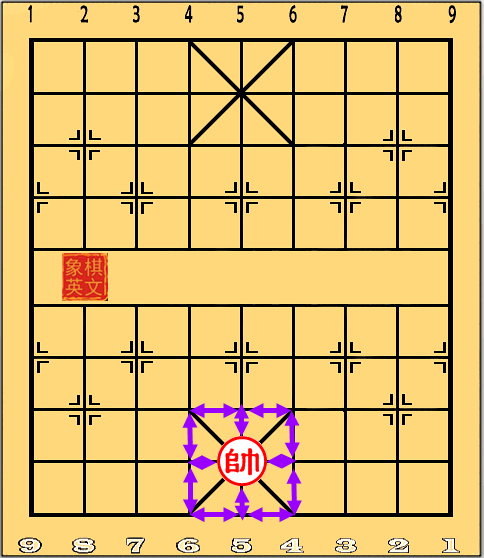
Red King= 帅shuài, Black King =将 jiàng.
Official English abbreviation: 'K.'
 |
 |
- Limitation on the board: Limited to the palace. Cannot leave the palace.
- Movement: Can advance/retreat/traverse to the adjacent intersection.
- Capturing Material: Same as movement. Moves to a new intersection and displaces any enemy piece.
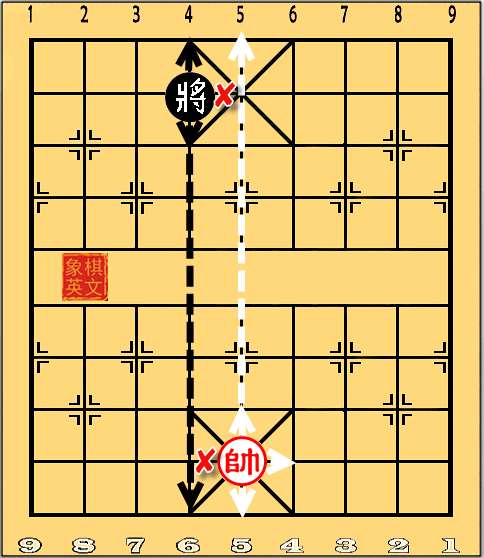 Other Notes:
Other Notes:
- Is affected by the Royal Rule.
- NO CASTLING.
- behaves differently when compared to its International Chess counterpart.
- Only nine intersections for a King to move.
The Royal Rule states that the opposing Kings CANNOT FACE EACH OTHER IN THE SAME FILE WITHOUT ANY INTERMEDIATE PIECE.
As can be seen in the diagram on the right, the Black King cannot traverse to the central file.
The Red King cannot move to the file on his left or the Royal Rule would be breached.
This special Royal Rule would grant the King a chariot-like power in the endgame phase.
The Kings CANNOT move diagonally.
Two Advisors
Red Advisor = 仕, Black Advisor = 士. Both are read as shì.
Official English abbreviation: 'A.'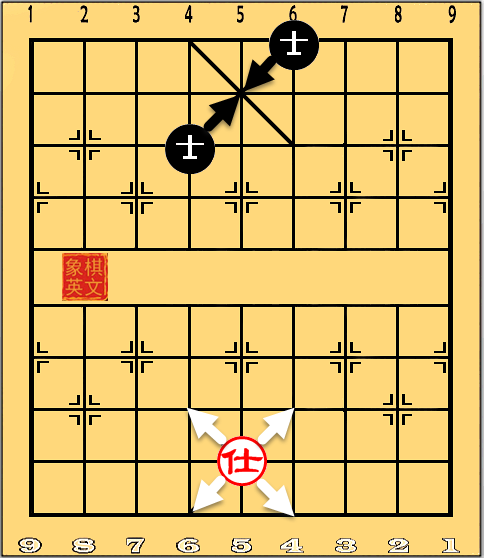
 |
 |
- Limitation on the board: Limited to the palace. Cannot leave the palace.
- Movement: Can advance/retreat to the adjacent diagonal in the palace.
- Capturing Material: Same as movement. Moves to a new intersection and displaces any enemy piece.
Other notes:
- Mainly a defensive piece.
- Some compare the Advisor to the Queen in International Chess, but they are simply different.
- Two Advisors would have to coexist with the King in the Palace, which can make the Palace congested.
Two Elephants 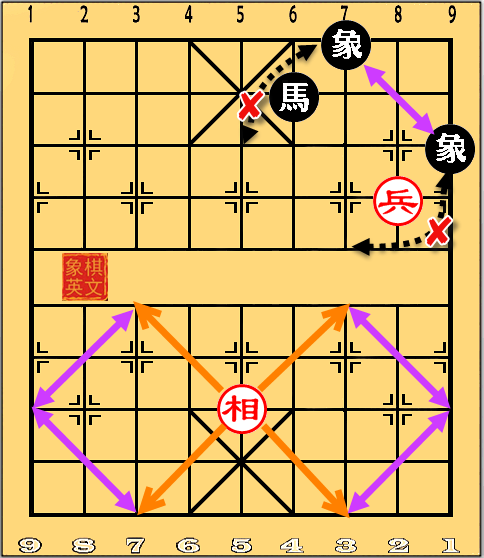
Red = 相 xiàng, Black = 象 xiàng.
Official English abbreviation: 'E.'
 |
 |
- Limitation on the board: Limited to one side of the river. It cannot cross the river.
- Movement: Can advance/retreat intersections diagonally in the same direction.
- Capturing Material: Same as movement. Moves to a new intersection and displaces any enemy piece.
Other notes:
- Mainly a defensive piece.
- Maximum of seven intersections on the board where the Elephant can move.
- It can be blocked.
- Limited in movement as compared to its International Chess counterpart, the Bishop.
In the Diagram shown on the right, the Black Elephant on the bottom rank is blocked by the Black Horse. The Black Elephant on the edge file is blocked by the Red Pawn. There are eight intersections on the board where the Elephant can be blocked and these eight intersections are known as the Elephant Eye(s). Of particular strategic important are the Elephant Eyes located in the palace.
Two Chariots 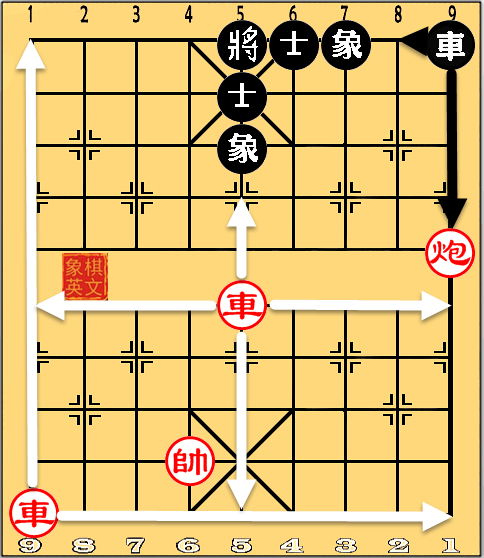
Both Red and Black = 车 jū.
Official English abbreviation: 'R' for 'chaRiot.'
 |
 |
- Limitation on the board: Unlimited
- Movement: Can advance/retreat/traverse any amount of intersections in the same line provided it is not blocked.
- Capturing Material: Same as movement. Moves to a new intersection and displaces any enemy piece.
Other notes:
- The only piece to behave exactly like its International Chess counterpart, the Rook.
- The most powerful piece on the board.
- The CORRECT pronounciation is jū in Chinese.
Two Horses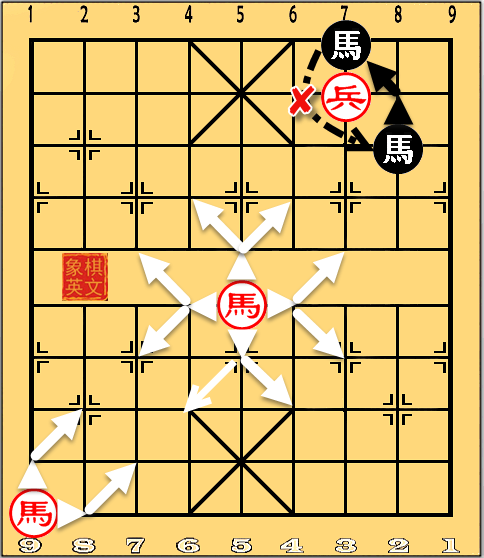
Both Red and Black = 马mǎ.
Official English abbreviation: 'H.
 |
 |
- Limitation on the board: Unlimited
- Movement: Can advance/retreat. A move by the Horse is completed after moving the Horse to the adjacent horizontal or vertical intersection followed by moving it diagonally to the adjacent intersection in the SAME DIRECTION.
- Capturing Material: Same as movement. Moves to a new intersection and displaces any enemy piece.
Other notes:
- Behaves similarly to its International Chess counterpart, the Knight.
- It can be BLOCKED. If the first adjacent horizontal/vertical intersection was occupied, the Horse cannot move in that direction.
Two Cannons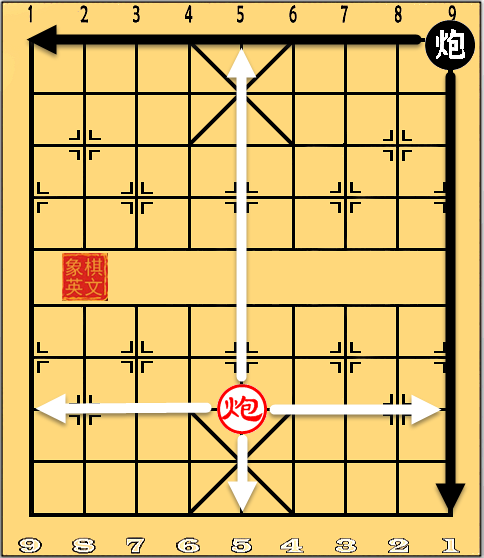
Red = 炮 , Black = 砲. Both are read as pào.
Official English abbreviation: 'C.'
 |
 |
- Limitation on the board: Unlimited
- Movement: Can advance/retreat/traverse as many intersections as it wants, provided it is not blocked. Movement is the SAME as the CHARIOT.
- Capturing Material: Only piece in Xiangqi, where a CANNON MOUNT is needed for the Cannon to jump over and capture the nearest enemy piece in the same line. Cannon mounts can be friendly or enemy pieces.
Other notes:
- No corresponding piece in International Chess.
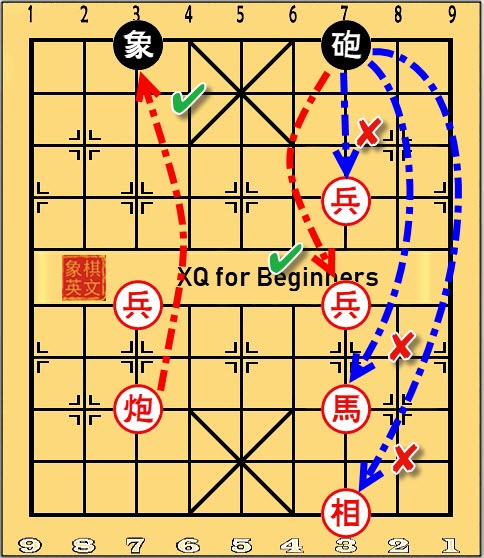 As can be seen in the adjacent diagram, the Red Cannon can capture the Black Elephant by jumping over the Red Pawn. (dotted Red arrow).
As can be seen in the adjacent diagram, the Red Cannon can capture the Black Elephant by jumping over the Red Pawn. (dotted Red arrow).
The Black cannon can only capture the Red Pawn on the Riverbank and no other piece.
The Cannon is perhaps the most intriguine piece to players with a background in Interational Chess.
Placing a Cannon on the line would give 'control' to the player as any enemy piece that is moved to the same file could be used as a Cannon Mount.
The Cannon Mount has also been described with other names in the past, but the official term is as such.
Five Pawns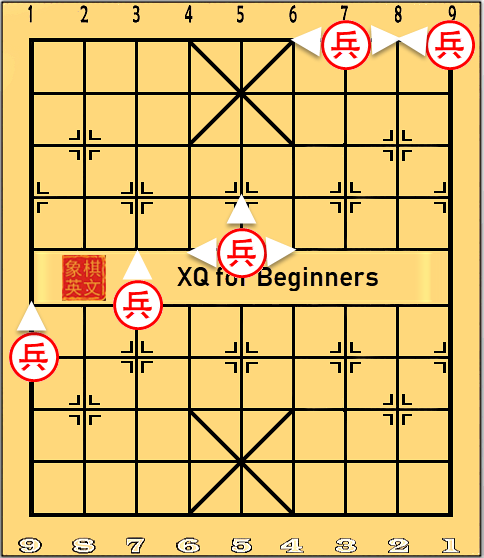
Red =兵 bīng, Black = 卒 zú.
Official English abbreviation: 'P.'
 |
 |
- Limitation on the board: can cross the river. However, before crossing the river, it can only advance one intersection forward.
- Movement: Can only advance one intersection BEFORE crossing the river. It can only advance/traverse to the adjacent intersection after crossing the river. Can only traverse after reaching the enemy's bottom rank.
- Capturing Material: Same as movement. Moves to a new intersection and displaces any enemy piece.
Other notes:
- NO PROMOTION OF PAWNS.
- NO EN PASSANT.
- Can NEVER retreat.
Click here to return to the top of the page.
Piece Value:
The following table has been collected from many books and represents the consensus on the value of each piece. It is only to be treated as a very rough estimate because other factors such as position or tactical combinations et cetera greatly affect the value of any piece.
|
Chess Piece |
Approximate Value |
Notes |
|
King |
Infinite |
Game is over if King is captured |
|
Advisor |
2 |
|
|
Elephant |
2.5 |
Some consider it be the same as the Advisor |
|
Chariot |
9 |
Most powerful piece |
|
Horse |
4 |
Weak in the opening, strong in the endgame |
|
Cannon |
4.5 |
Strong in the opening, weak in endgame (due to lack of cannon mounts) |
|
Pawn |
Depends |
1 point before crossing the river. 2 points after crossing the river. 1 point after reaching the enemy bottom rank. |
The Array
The starting position of the pieces is shown below. It is known as the array.
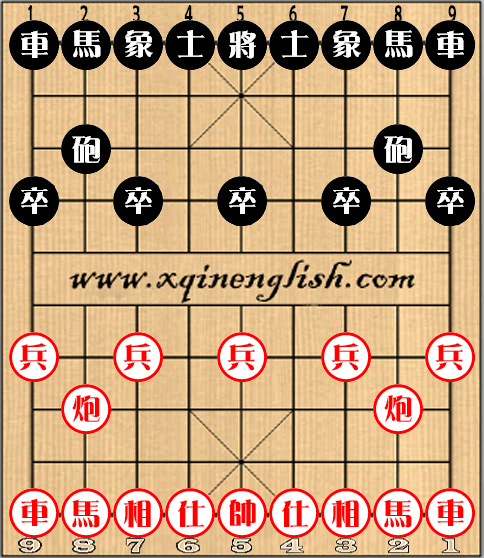
Some reflections on the use of Chinese characters/ideograms, 2D, and 3D pieces:
There has been much debate over the internet in different Facebook groups and other forums about the issue of recognizing Chinese characters or ideograms. There are two polarizing groups:
- people for using Chinese characters/ideograms and two-dimensional pieces,
- people against using Chinese characters/ideograms, but can accept two-dimensional pieces,
- people against using Chinese characters and two-dimensional pieces altogether.
Some folks in the latter two groups even advocate using three-dimensional pieces to represent the chess pieces as they claim that it would help promote Xiangqi better. This issue would be discussed in another article.
However, for the sake of argument, while there is nothing wrong with starting off with three-dimensional pieces or inscriptions instead of Chinese characters/ideograms, if you were to play ultimately in tournaments, the official Xiangqi sets would contain circular discs with Chinese ideograms inscribed on them.
Click here to return to the top of the page.
More Introduction to Xiangqi
For a general overview of Xiangqi,
For more about Xiangqi and its technical aspects, please refer to the following links:
An introduction of the chessboard,
The game itself is further divided into three phases:
Midgame phase, and
Each of the phases will have its sections on the Website.
Finally, there are human-made puzzles that have existed during the Song Dynasty. The AXF has called these human-made puzzles Endgame Compositions.
In the following section, the Webmaster will go through each item in detail.
Click here to return to the top of the page.
Important Reminder
Before the Webmaster continues, he would like to remind the visitor that:
the OFFICIAL name for the game is Xiangqi, not Chinese Chess.
The official name can be found in the World Xiangqi Rules, which was published in 2018.[1] The World Xiangqi Rules were approved and authorized by the World Xiangqi Federation (WXF) and the Chinese Xiangqi Association (CXA).
There are many posts, blogs, and apps on the internet that continue to use 'Chinese Chess' in their articles, which is acceptable, but they fail to acknowledge the official name. More often than not, the translations of the terms were not based on the recommended terms found in the World Xiangqi Rules.
To promote Xiangqi, the Webmaster has chosen to use Xiangqi (Chinese Chess) in his articles, or simply Xiangqi.
Click here to return to the top of the page.
FAQs about How to Play Xiangqi
For visitors new to the site, the Webmaster has compiled a list of frequently asked questions and added links to various pages on the Website:
How do I play Xiangqi (Chinese Chess)? --> See article above.
Is Chinese Chess harder than Chess? ... and other comparisons between Xiangqi and International Chess. Click here.
Who goes first in Chinese Chess? --> See Rules of Xiangqi above.
What are the rules for a simple game of Xiangqi? ---> See Rules of Xiangqi above.
Where can I play Xiangqi? ---> For online play, click here.
Is there a stalemate in Xiangqi? --> Yes, but unlike International Chess, a stalemate would be counted as a loss for the King placed under stalemate. You cannot refuse to move in Xiangqi. See Rules of Xiangqi above.
If there are any more questions, please email the Webmaster at
Click here to return to the top of the page.
References
1. 世界象棋联合会;中国象棋协会. 世界象棋规则. 北京 : 人民体育出版社, 2018. 978-75009-5141-9.
2. 屠, 景明 and 杨, 柏伟. 象棋词典. 上海 : 上海文华出版社, 2009. 978-7-80740-339-5/G。475.
3. 王, 国栋, 方, 士庆 and 李, 燕贵. 跟我学象棋 初级教程. 成都 : 成都时代出版社, 2010. 978-7-80705-517-4.
4. 刘, 殿中. 象棋新编课程 象棋初学门径. 北京 : 北京体育大学出版社, 2000. 7-81051-484-9.
5. 朱, 宝位. 棋牌入门丛书 象棋入门. 合肥 : s.n., 1994. 978-7-5337-0734-7.
6. Png, Jim Hau Cheng. Lexicon of Xiangqi (Chinese Chess) Terms in English. Taipei : Jim Png Hau Cheng, 2017. 978-957-43-4707-0.
7. —. Understanding the Elephant: A Xiangqi Primer Part 2: Basic Introduction and Basic Kills. Taipei : Self-published, 2016. 978-957-43-3999-0 .
